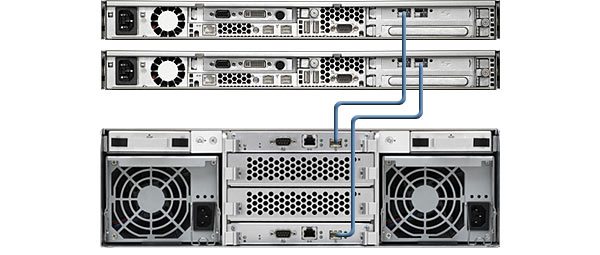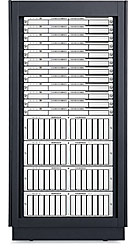
|
| Xserve RAID features dual 2Gb Fibre Channel
ports for ultrafast data transport between the storage system and the host
computer. Previously available only in high-end RAID systems, this industry-standard
interconnect technology provides superior bandwidth, availability and deployment
flexibility over earlier-generation SCSI technology. 400MB/s throughput  Each 2Gb Fibre Channel port offers 200MB/s bandwidth for a total throughput
of up to 400MB/s. Fibre Channel is the only storage connectivity technology
that provides guaranteed bandwidth, so the host computer receives data at
the same high speed as the RAID system sends it out.
Each 2Gb Fibre Channel port offers 200MB/s bandwidth for a total throughput
of up to 400MB/s. Fibre Channel is the only storage connectivity technology
that provides guaranteed bandwidth, so the host computer receives data at
the same high speed as the RAID system sends it out.Superior scalability and simplicity In contrast to Gigabit Ethernet or SCSI technologies, adding storage units to a Fibre Channel network won’t lead to congestive data loss or reduced overall bandwidth. The highly scalable Fibre Channel technology can address up to 126 devices per loop, with each device receiving a full 200MB/s throughput. SCSI technology allows for a maximum of only 15 devices per channel, which means that large SCSI arrays involve added expense and complexity. Flexible deployment capabilities The Fibre Channel interface supports multiple topologies and transport protocols, providing flexible deployment options to suit different applications. While SCSI supports only dedicated point-to-point connections, Fibre Channel can be configured using point-to-point, loop and switched fabric topologies. Point-to-point. The simplest storage topology, point-to-point employs a direct connection between the disk array and the host computer. With two Fibre Channel ports, Xserve RAID offers point-to-point connectivity for up to two host systems. Each host has independent access to a RAID set of up to seven drives. Loop. This topology employs a Fibre Channel hub to connect multiple servers and storage devices. The 2Gb/s Fibre Channel bandwidth is shared among all devices connected to the hub. Only two systems can communicate with one another at the same time. Switched fabric. Similar to an Ethernet infrastructure, this storage topology uses Fibre Channel switches to connect multiple disk arrays and devices. A switched fabric is the most flexible topology, because it allows all the connected servers and storage devices to communicate with one another simultaneously — without sharing bandwidth. |
Long-distance connectivity Xserve RAID connects to a 2Gb Fibre Channel PCI Card in the host computer via a thin, flexible copper or fiber-optic cable. The Fibre Channel interface also provides support for much longer distances between the storage and the host system than is possible over SCSI cables. The Apple Fibre Channel PCI Card accepts optical transceivers, allowing it to use fiber-optic cables that can extend over 500 meters. This is particularly useful for organizations using Xserve RAID to back up or archive critical data.  Apple Fibre Channel PCI Card
Apple Fibre Channel PCI CardXserve RAID connects to a host Xserve or Power Mac G4 system using the dual-port 2Gb Apple Fibre Channel PCI Card (sold separately). This high-speed storage interface offers dedicated bandwidth with a throughput of up to 400MB/s. The Fibre Channel interconnect technology supports multiple application environments, using point-to-point, loop and fabric topologies. The PCI card comes with two 2.9-meter (9.5-foot) copper cables.  For connecting over longer distances Apple’s card accepts SFP (Small
Form Factor Pluggable) optical transceivers for use with fiber-optic cables.
For connecting over longer distances Apple’s card accepts SFP (Small
Form Factor Pluggable) optical transceivers for use with fiber-optic cables. |
| . | . | . |
| - |
RAID
|
Februar |
|
Xserver RAID
|
2003
|